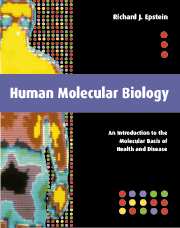Book contents
- Frontmatter
- Contents
- Preface
- Acknowledgements
- Read me first …
- Glossary
- Dedication
- Introduction: A disease for every gene?
- I From molecular biology to human genetics
- II From molecular genetics to human biochemistry
- III From molecular biochemistry to human cell biology
- IV From molecular cell biology to human physiology
- V From molecular physiology to human molecular biology
- 21 Genetic experimental systems
- 22 Gene and protein analysis
- 23 Genetic engineering, gene mapping, and gene testing
- 24 Gene knockouts, transgenics, and cloning
- 25 Gene therapy and recombinant DNA technology
- Index
23 - Genetic engineering, gene mapping, and gene testing
Published online by Cambridge University Press: 01 June 2011
- Frontmatter
- Contents
- Preface
- Acknowledgements
- Read me first …
- Glossary
- Dedication
- Introduction: A disease for every gene?
- I From molecular biology to human genetics
- II From molecular genetics to human biochemistry
- III From molecular biochemistry to human cell biology
- IV From molecular cell biology to human physiology
- V From molecular physiology to human molecular biology
- 21 Genetic experimental systems
- 22 Gene and protein analysis
- 23 Genetic engineering, gene mapping, and gene testing
- 24 Gene knockouts, transgenics, and cloning
- 25 Gene therapy and recombinant DNA technology
- Index
Summary
People say that the human genome is now sequenced, but what exactly do they mean? Your genome or mine?
Hard as it may be to believe, you share 99.9% of your genetic structure with other people you see on the street. In other words, only 0.1% of your genome is uniquely “you”. This 0.1% consists of repetitive DNA variations, gene polymorphisms, intronic variants, splice junction aberrations, imprintings, and perhaps a few amplification and missense mutation events. These latter anomalies may manifest in some instances as disease phenotypes, but may also predispose to disease susceptibilities that only become manifest in conjunction with other genetic variations or environmental exposures.
Sequencing the genome thus provides a reference point for interpreting variations – many of which may have little if any functional significance. Equally, however, many apparently functionless polymorphisms may prove to have genetic significance. The next generation of biomedical scientists will grapple with the complexities of correlating gene structure with (human) function. A prerequisite for this challenge will be the basic tools of molecular biology, as described briefly in this section.
Constructs and vectors
Genes are packaged into vectors for expression in vitro
Isolating a gene of interest is only a first step towards characterizing the gene's function. The structure of the gene may provide clues as to its function – marking it, for example, as a member of a particular gene superfamily – but the cellular context in which normal gene expression occurs is also likely to be important.
- Type
- Chapter
- Information
- Human Molecular BiologyAn Introduction to the Molecular Basis of Health and Disease, pp. 562 - 576Publisher: Cambridge University PressPrint publication year: 2002



